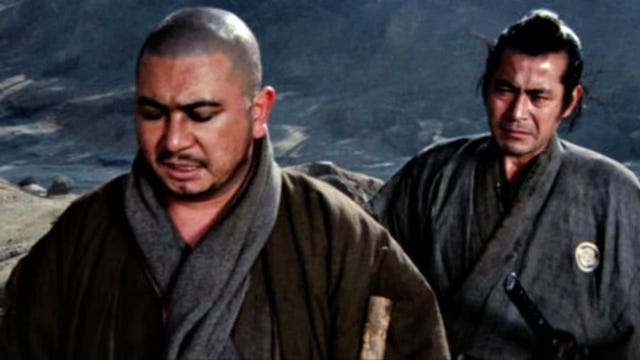The first time I saw Akira Kurosawa's Seven Samurai, I felt like I'd been smacked in the teeth by a katana-wielding philosopher. It wasn't just a movie—it was a full-frontal assault on my senses. Rain-soaked warriors, desperate villagers, honor-bound killers riding toward their doom—chaos and poetry in the same breath. This was cinema distilled to its purest form: raw, brutal, and beautiful.
But here's what struck me most: these weren't the clean-cut, honor-obsessed samurai reciting haikus before committing seppuku. These were flawed, desperate men caught between survival and principle, pragmatism and idealism. The real power of samurai cinema lies not in its adherence to the romanticized bushido code—that blend of loyalty, honor, discipline, and self-sacrifice that governed feudal Japan—but in how it exposes the brutal contradictions beneath that noble veneer.
Samurai films grip us with themes as old as war itself: honor versus survival, vengeance versus forgiveness, the eternal battle between what must be done and what should be done. A ronin with no master, wandering the wasteland with nothing but his blade and his code, is just another way of saying: here is a man against the world.
These stories transcend Japan, bleeding into every corner of cinema. Sergio Leone lifted A Fistful of Dollars wholesale from Kurosawa's Yojimbo, transplanting the nameless warrior from feudal Japan to the American West. Quentin Tarantino's entire aesthetic—the sudden violence, the moral ambiguity, the mythic loners—owes a blood debt to samurai cinema. Even George Lucas built Star Wars on the bones of The Hidden Fortress, turning Kurosawa's peasant perspective and wipe transitions into a space opera for the ages.
The action in these films is violent ballet—every duel a meditation on life and death. Watch Harakiri and feel Masaki Kobayashi's devastating critique of blind loyalty shake you to the core. Watch Yojimbo and try not to smirk at Toshiro Mifune's lethal swagger as he plays rival gangs against each other. These films are masterpieces not just in their storytelling, but in their cinematography, their movement, their unshakable philosophy that violence is both necessary and damning.
Which brings me to a dynamic favorite from 1970 that perfectly embodies these contradictions: Zatoichi Meets Yojimbo—the blind swordsman versus the scruffy, nameless mercenary. Two absolute legends, two very different philosophies, both cut from the same bloody cloth.
Zatoichi is the reluctant hero incarnate. Blind, seemingly helpless, he sees more than most men with eyes wide open. His walking stick conceals a razor-sharp blade, and when he draws it, fights end before they begin. He's got a conscience, champions the underdog, and leaves behind a trail of bodies—and sometimes, a prayer for the dead.
Yojimbo represents the opposite extreme. Mifune's scruffy mercenary harbors zero illusions about honor or justice. He's a trickster who manipulates rival gangs for sport, profits from chaos, and shows mercy only by accident. Where Zatoichi kills because he must, Yojimbo kills because it pays. Where Zatoichi fights with instinct and lightning speed, Yojimbo employs cunning and brutal strategy, rarely drawing his sword unless he's certain it will be fatal.
In Zatoichi Meets Yojimbo, director Kihachi Okamoto throws these legends into a corrupt town torn between two rival gangs. The plot is elegantly simple: Zatoichi arrives seeking an old friend and discovers a community rotting from within. Yojimbo shows up looking for easy money and finds profitable chaos. Neither man trusts the other, and both know it will end in blood.
But this isn't just another crowd-pleasing team-up. The film's tone is darker than most Zatoichi entries—bleak, cynical, soaked in moral rot. Shintaro Katsu brings his usual mix of lethal grace and reluctant compassion, while Mifune's Yojimbo appears older, more bitter, less ronin than ghost. Their scenes together crackle with tension as they circle each other like wary wolves, each recognizing in the other a kindred spirit shaped by violence.
When they finally clash, the sword fights are quick, ugly, and deadly—no choreographed dance, but real violence with real consequences. The town cannot be saved; everyone knows it. By the end, there's no real winner, just two warriors doing what they do best in a world that has no use for their particular brand of justice.
The samurai are long gone, but their ghosts remain, flickering across screens worldwide, forever caught between honor and oblivion. These films endure because they capture something essential about the human condition: the struggle to maintain dignity in an undignified world, to find meaning in meaningless violence, to forge a code worth living—and dying—by.
If you've never taken a deep dive into samurai cinema, if you've never felt the full weight of Throne of Blood crashing down like a Shakespearean fever dream, then dim the lights and prepare to enter the storm. Because once you go down this path, there's no coming back—and that's exactly the point.
If you’re a fan of Zatoichi, Yojimbo, or samurai movies in general, this is a must-watch. Not for the plot, but for the sheer joy of watching two legends share the screen. But of course, I realize, this won’t be everyone’s cup of Green Tea.
_ _ _ _
Until we meet again, let your conscience be your guide.






Ha, yes, the Seven Samurai affected me deeply, as well, even the American remake of the Magnificent Seven.
While I prefer, as a woman, perhaps, gentler Japanese films, like Woman in the Dunes, I will forever remain a fan of the Seven Samurai!
Back in the 70s in the summer to escape the city heat I'd go to the The Thalia, a tiny Upper West Side theater that would show all the Japanese Samurai films...The Zatoichi films are my favorites.